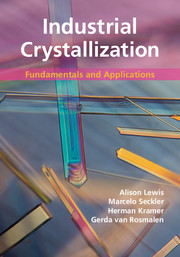Book contents
- Frontmatter
- Contents
- Nomenclature
- Industrial crystallization in practice: from process to product
- 1 Thermodynamics, crystallization methods and supersaturation
- 2 Characterization of a crystalline product
- 3 Basic process design for crystallization
- 4 Nucleation
- 5 Crystal growth
- 6 Agglomeration
- 7 The population balance equation
- 8 Batch crystallization
- 9 Measuring techniques
- 10 Industrial crystallizers
- 11 Precipitation and anti-solvent crystallization
- 12 Melt crystallization
- 13 Additives and impurities
- 14 Polymorphism
- Index
- References
10 - Industrial crystallizers
Published online by Cambridge University Press: 05 July 2015
- Frontmatter
- Contents
- Nomenclature
- Industrial crystallization in practice: from process to product
- 1 Thermodynamics, crystallization methods and supersaturation
- 2 Characterization of a crystalline product
- 3 Basic process design for crystallization
- 4 Nucleation
- 5 Crystal growth
- 6 Agglomeration
- 7 The population balance equation
- 8 Batch crystallization
- 9 Measuring techniques
- 10 Industrial crystallizers
- 11 Precipitation and anti-solvent crystallization
- 12 Melt crystallization
- 13 Additives and impurities
- 14 Polymorphism
- Index
- References
Summary
Why this chapter is important
Once the type of crystallization process has been chosen, it is necessary to select the most suitable crystallizer. This chapter focuses on the various types of commercially available crystallizers for evaporative and cooling crystallization. The list of crystallizers makes no pretence at being complete, and only serves as a means to highlight important features of various types of crystallizers to achieve the desired product specifications. These features are related to actuators for control (fines removal, classified product removal or a combination of both) that are available in the various types of crystallizers to manipulate the CSD. There are also other features of the crystallizers that inherently affect the CSD through their impact on the hydrodynamics of the crystallizer design. In this chapter, the various designs and their effect on the final CSD of the product will be discussed.
Criteria for the choice of a crystallizer
To understand how the differences in the design between the various crystallizers affect the product quality, detailed models are needed, as discussed in Chapter 7 on population balance modeling (Bermingham et al.,8a, Kramer et al., 1999). As explained in Chapter 7, the models divide the crystallizers into a number of compartments to be able to describe the effects of the hydrodynamics on the crystallization kinetics.
So, apart from giving guidance on the selection of the most appropriate crystallizer, the most appropriate compartment structures for the modeling of these crystallizers will be discussed.
In this chapter we will only discuss crystallizers for cooling and evaporative crystallization processes. Precipitation and anti-solvent crystallizers in which mixing of feed streams together or with the bulk liquor strongly affects the product properties requires a different approach in the selection of the nozzles as well as the vessel and stirrer design, and will be treated in Chapter 11. Melt crystallization, which is merely applied as an ultra-purification process, also requires a different selection procedure and will be treated in Chapter 12.
- Type
- Chapter
- Information
- Industrial CrystallizationFundamentals and Applications, pp. 210 - 233Publisher: Cambridge University PressPrint publication year: 2015



